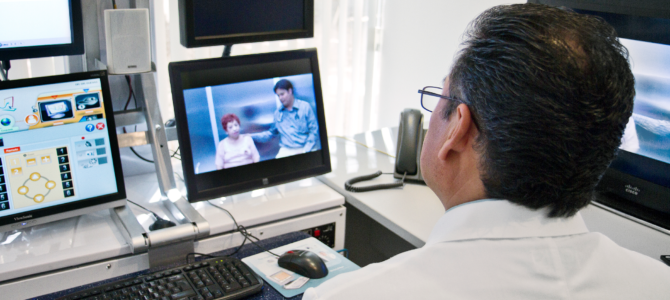
Over the last few weeks, the deregulation of telehealth has revolutionized the American health-care industry, transforming the delivery of care with unprecedented speed and showing which players will prove virtually adaptable.
Defined by the American Academy of Family Physicians as “the practice of medicine using technology to deliver care at a distance,” telemedicine refers to remote clinical care: a physician in one location delivering care to a patient at a distant site over telecommunication. The scope of telehealth is broader, referring to “electronic and telecommunications technologies and services used to provide care and services at-a-distance.”
Due primarily to government regulations, telehealth has lagged technological advances in medicine over the past decade, with remote platforms and care slow to gain state approval. Federal medical privacy law and Medicaid and Medicare regulations are cumbersome and restrictive, and state regulations vary.
A 2019 study found 66 percent of patients had never used a virtual platform for health services and 63 percent of patients didn’t understand their telemedicine insurance coverage. As of 2017, only 30 percent of physicians reported telemedicine usage. The market hasn’t struggled to innovate; it has struggled to exist.
But on March 17, all of that changed when the first major COVID-19 legislation passed, prompting guidance from the Centers for Medicare and Medicaid Services (CMS) that expanded telehealth reimbursement to in-home patient care and eliminated geographic requirements for coronavirus emergencies.
The March 31 passage of the Coronavirus Aid, Relief, and Economic Security Act further updated CMS guidance, approving inpatient services and reimbursement for some telephone codes. The legislation also specified that certain health clinics could function as distant site providers, but CMS has yet to provide specific guidance, leaving restrictions on their services.
States also began expanding telehealth policies. “Either they are allowing patients to be located in their homes, allowing for use of telephone, or expanding services or providers who can provide telehealth services for Medicaid,” said Christine Calouro, a Center for Connected Health Policy associate and telehealth expert. “Many are also providing licensing exceptions to allow out-of-state providers to provide services in their state. Some states that did not have the requirement that private payers reimburse for telehealth issued executive orders or regulations requiring the insurers reimburse for it.”
How It Works and Who Benefits
The Wuhan coronavirus crisis has led to unprecedented health policy changes. Medical facilities and governing orders advised patients to cancel or delay non-emergent care, and hospitals severely restricted visitor policies. Federal leaders encouraged social distancing. State governments issued stay-at-home and shelter-in-place orders. And businesses deemed nonessential closed.
Some businesses and health centers have fared better than others. Behavioral health services, deemed essential under the telemedicine ruling, have done well in transitioning.
Licensed Clinical Psychologist Carrie Nowell manages Atlantic Counseling Group in Loudoun County, Virginia. The practice runs five offices with nearly 50 treating providers and offers a large range of behavioral health services including counseling, medication management, and psychological testing. Before the outbreak, the practice provided some telehealth services, but now the group’s services are provided completely through telehealth. Nowell says the loosened restrictions have made a wider range of services available, while providing better coverage for them.
Primary care practices are also primed to use virtual options, especially when treating established patients. Telemedicine can work well for managing chronic conditions, including follow-up discussions, according to Philip Eskew, an attorney, the founder of DPC Frontier, and a site medical director for Corizon Health in Wyoming. He says it’s also effective for discussing COVID-19 with patients, since the diagnosis is based on history rather than a physical examination.
“Over time, things that are elective and not urgent can become urgent and emergent, though,” Eskew said. “Lots of procedures will be postponed, and this could create various bottlenecks long-term that might be tough to predict right now.”
Unlike behavioral health practices, primary care providers are hesitant to take new patients without the possibility of a physical exam. Establishing a new patient relationship is difficult with telemedicine, which is also limited in utility for neurological and orthopedic cases. However, some specialists, physical and occupational therapists, obstetric groups, and even chiropractors are finding their footing in what was previously a more niche field.
“I can’t do everything that I normally would with an exam, but I can still diagnose discogenic radiculopathy and recommend referral for MRI and ortho consults,” said Peder Angell, a chiropractor at Airrosti, a musculoskeletal health care group in San Antonio, Texas. “Obviously, I can’t do adjustments or manual therapy or passive modalities over FaceTime, but active rehab, definitely … with several people at once. I think there is some room for chiropractors to be relevant on the internet.”
Special-needs children who receive a range of therapies through school-based programs may be at the greatest disadvantage from the current bans on medical services, since they are not established with private practices and require in-person prompts and observation.
“We have been offered speech therapy and occupational therapy, and I considered doing the speech but ultimately decided not to, at least for now,” said Catherine Valandra, the mother of a severely speech-delayed 3-year-old child in Alexandria, Virginia. “I can provide physical and verbal redirection and try to keep [my daughter] focused, but without the receptive language skills, the therapists can miss so much that they wouldn’t miss when in the same room.”
The impact on dentistry has been particularly acute, with practices across the country shutting their doors following state-led orders to provide only emergency care.
This past legislative session, the Virginia Dental Association lobbied to define teledentistry. Significantly limited compared to telemedicine, teledentistry commonly relies on photo-sharing of a broken tooth to determine treatment. The only real service dentists can provide remotely is calling in prescriptions for tooth aches, noted Justin Norbo, president of the Northern Virginia Dental Society and a Virginia Dental Association board member.
Amid coronavirus and economic uncertainty, dental offices are contemplating complete lay-offs, furloughs, or termination of entire office teams. Norbo’s office is operating with limited hours for emergencies only until April 24, and likely longer.
New Platforms Available to Providers
Popular telecommunications platforms FaceTime, Skype, and Zoom have quickly monopolized the approved telehealth servers space. Provider and patient familiarity and accessibility are trumping security concerns and regulations.
“HIPAA [federal medical privacy] requirements have been relaxed that allows use of smartphones to deliver services and also use of software that isn’t necessarily compliant with HIPAA, such as Facetime or Skype,” Calouro said. “However, state privacy and confidentiality requirements would still apply. But I would think that providers are taking advantage of that if they can.”
Before COVID-19, telehealth policies varied across the United States, depending what insurance companies would reimburse. Federal Medicare reimbursement was limited. Calouro said patients had to be in rural areas and specific health-care facilities, and even then they would only receive reimbursement for limited services at limited providers.
The pandemic’s effects on the future of virtual care are yet to be seen. New HIPAA-compliant virtual delivery models entering the market may eventually push out less secure formats. Patient and practitioner wariness of virtual health services could wane, or organizational funding might finally be allocated to modernize in-office tech.
“I believe everything I have seen thus far has been temporary and time-limited to the COVID-19 emergency, which means theoretically all the policies will go back to their pre-COVID-19 status after all this is over,” Calouro said. “But it’s also possible that the policies get extended, or the original policies are amended, as people get more used to using telehealth and it becomes more integrated into care delivery due to this virus.”









